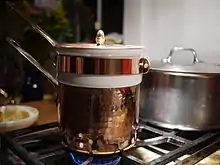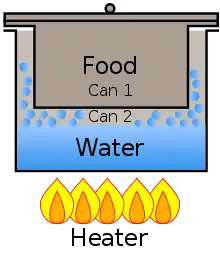Bain-marie
A bain-marie (pronounced [bɛ̃ maʁi]; also known as a water bath or double boiler), a type of heated bath, is a piece of equipment used in science, industry, and cooking to heat materials gently or to keep materials warm over a period of time. A bain-marie is also used to melt ingredients for cooking.

History
.tif.jpg.webp)
The name comes from the medieval-Latin term balneum (or balineum) Mariae—literally, Mary's bath—from which the French bain de Marie, or bain-marie, is derived. In his books, the 300 AD alchemyst Zosimos of Panopolis credits for the invention of the device Mary the Jewess,[1] an ancient alchemist. However, the water bath was known many centuries earlier (Hippocrates and Theophrastus).[2]
Description

The double boiler comes in a wide variety of shapes, sizes, and types, but traditionally is a wide, cylindrical, usually metal container made of three or four basic parts: a handle, an outer (or lower) container that holds the working fluid, an inner (or upper), smaller container that fits inside the outer one and which holds the material to be heated or cooked, and sometimes a base underneath. Under the outer container of the bain-marie (or built into its base) is a heat source.
Typically, the inner container is immersed about halfway into the working fluid.
The smaller container, filled with the substance to be heated, fits inside the outer container filled with the working fluid (usually water), and the whole is heated at, or below, the base, causing the temperature of the materials in both containers to rise as needed. The constant boiling temperature of the water helps to keep contents of the inner pot from boiling or scorching.
When the working fluid is water and the bain-marie is used at sea level, the maximum temperature of the material in the lower container will not exceed 100 °C (212 °F), the boiling point of water at sea level. Using different working fluids, for example, oil, in the lower container will result in different maximum temperatures.
Alternatives
A contemporary alternative to the traditional, liquid-filled bain-marie is the electric "dry-heat" bain-marie, heated by elements below both pots. The dry-heat form of electric bains-marie often consumes less energy, requires little cleaning, and can be heated more quickly than traditional versions. They can also operate at higher temperatures, and are often much less expensive than their traditional counterparts.
Electric bains-marie can also be wet, using either hot water or vapor, or steam, in the heating process. The open, bath-type bain-marie heats via a small, hot-water tub (or "bath"), and the vapour-type bain-marie heats with scalding-hot steam.
Culinary applications
In cooking applications, a bain-marie usually consists of a pan of water in which another container or containers of food to be cooked is/are placed.[3]
_-_Bain-marie_au_four.jpg.webp)
- Chocolate can be melted in a bain-marie to avoid splitting (separation of cocoa butter and cocoa solids, breaking emulsion) and caking onto the pot. Special dessert bains-marie usually have a thermally insulated container and can be used as a chocolate fondue for the purposes of dipping foods (typically fruits) at the table.
- Cheesecake is often baked in a bain-marie to prevent the top from cracking in the centre.
- Baked custard desserts such as custard tarts may be cooked in a bain-marie to keep a crust from forming on the outside of the custard before the interior is fully cooked. In the case of the crème brûlée, placing the ramekins in a roasting pan and filling the pan with hot water until it is half to two-thirds of the way up the sides of the ramekins transfers the heat to the custard gently, which prevents the custard from curdling. The humidity from the steam that rises as the water heats helps keep the top of the custard from becoming too dry.[4]
- Classic warm high-fat sauces, such as Hollandaise and beurre blanc, are often cooked using a bain-marie as they require enough heat to emulsify the mixture of fats and water but not enough to curdle or split the sauce.
- Some charcuterie such as terrines and pâtés are cooked in an "oven-type" bain-marie.
- Thickening of condensed milk, such as in confection-making, is done easily in a bain-marie.
- Controlled-temperature bains-marie can be used to heat frozen breast milk before feedings.
- Bains-marie can be used in place of chafing dishes for keeping foods warm for long periods of time, where stovetops or hot plates are inconvenient or too powerful.
- A bain-marie can be used to re-liquefy hardened honey by placing a glass jar on top of any improvised platform sitting at the bottom of a pot of gently boiling water.
Other uses
In small scale soap-making, a bain-marie's inherent control over maximum temperature makes it optimal for liquefying melt-and-pour soap bases prior to molding them into bars. It offers the advantage of maintaining the base in a liquid state, or reliquefying a solidified base, with minimal deterioration. Similarly, using a water bath, traditional wood glue can be melted and kept in a stable liquid state over many hours without damage to the animal proteins it incorporates.
References
- Principe, Lawrence M. (2013). The secrets of alchemy. Chicago: The University of Chicago Press. ISBN 9780226923789.
- Edmund Lippmann (1919), Entstehung und Ausbreitung der Alchemie, Springer, p. 50
- Beck, S. (2013). Simca's Cuisine. Knopf Doubleday Publishing Group. p. 441. ISBN 978-0-8041-5047-7. Retrieved 2017-10-12.
- "Techniques: Bain Marie". DrGourmet.com. Archived from the original on 2011-06-04. Retrieved 2011-07-20.
External links
 Media related to Bain-marie at Wikimedia Commons
Media related to Bain-marie at Wikimedia Commons The dictionary definition of bain marie at Wiktionary
The dictionary definition of bain marie at Wiktionary